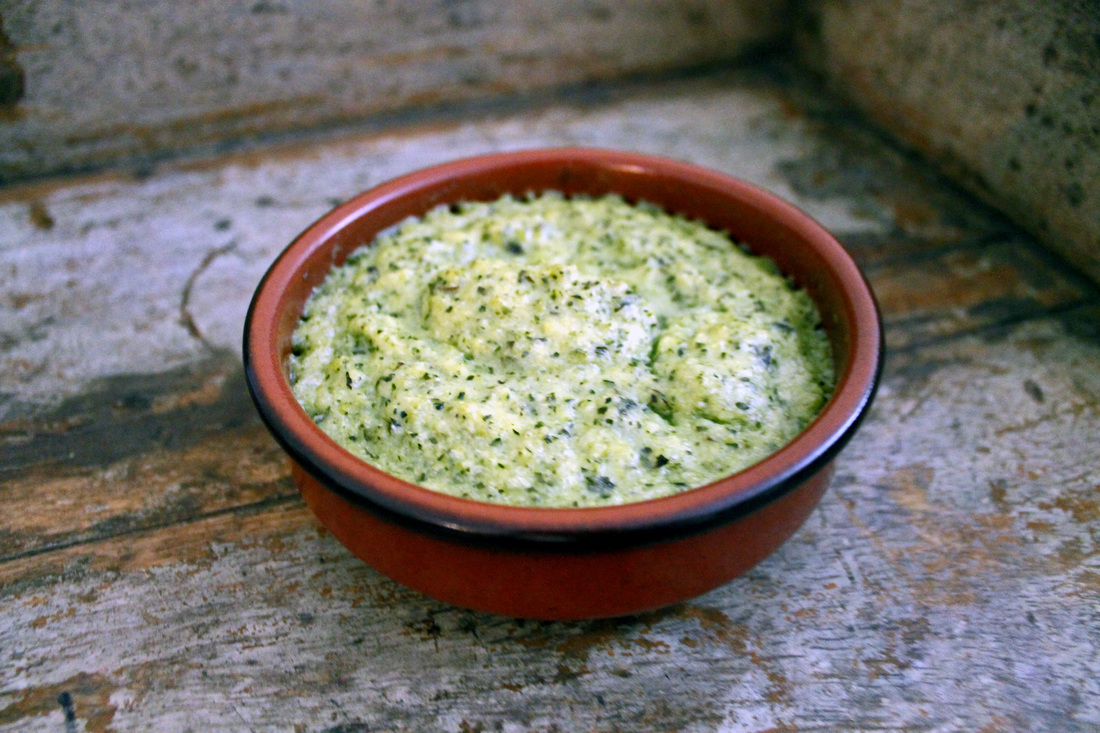Warm minted broccoli and courgette dip (Paleo, AIP, low FODMAP)
I love broccoli. It is highly nutritious, packed with vitamin C, vitamin A, calcium and boasts an impressive array or anti cancer and anti viral properties. Broccoli however does not reciprocate my love. In large quantities it leaves me in digestive discomfort and emotional turmoil. As FODMAPS culprits go, its well up there.
However, those beautiful people at Monash University responsible for developing the low FODMAP diet have tested the FODMAP content of this nourishing vegetable for us and deemed it to be low in small portions. Hooray! Half a cup is suggested a safe limit for someone with FODMAP intolerance but you may want to add this into your diet in smaller portions if you have a super sensitive tum. Armed with this knowledge there was no way I was going to carry on depriving myself of all the benefits that come from this lovely little vegetable. Better still I was going to get creative with it and a few more nourishing ingredients. Et voila, my minted broccoli and courgette dip was born. This is perfect served hot as a side dish, served cool as a dip for raw veggies, or even as a coating for some oven baked chicken. Serves 4 Ingredients: 2 cups of broccoli (dividing the dip into 4 once cooked will give you a low FODMAP portion) 2 medium courgettes thinly sliced into discs. Two fistfuls of fresh mint leaves. Mint has great digestive supporting qualities, relieves muscle pains and alleviates allergy symptoms. The juice of one whole lemon. Packed with vitamin C, magnesium, potassium, folate and vitamin B6. 2 tablespoons of coconut oil (see below link for my favourite coconut oil) 2 tablespoons of garlic oil a good pinch of sea salt or pink Himalayan salt Equipment: Food processor/hand held blender Saucepan Baking dish or four ramekins Method: Heat your oven to 200 degrees or 180 for fan assisted. In a small saucepan, boil your broccoli pieces until just cooked. You want it Al dente and not too soft. Once this is cooked transfer to your food processor or blender, leaving half a cup of water in the saucepan. To the blender add the coconut oil, mint leaves, garlic oil, lemon juice and salt. Add your sliced courgette to the hot water in the saucepan and cook on low/medium for about five minutes until it begins to soften. Again you do not want to overcook this. Once cooked, transfer your courgettes to the blender along with a tablespoon of the water from the pan. Pulse for about 40 seconds to 1 minute. You want the mixture to be well combined and thick with a bit of texture still. You do not want to over blend the mixture so it becomes runny. Taste the mixture and add more salt, lemon of garlic oil to taste. Once your mixture is at a thick and almost smooth consistency, pour into a baking dish or separate into four individual ramekins. This way you are ensuring you have a low FODMAP portion. Bake at the top of the oven for 15 minutes until bubbling and starting to turn golden on top.
0 Comments
What are FODMAPs?Before I move on to post about the next phase of my healing, I want to introduce you to the world of FODMAPs. Because I will inevitably mention them A LOT. If you suffer from any type of digestive distress, or have ever been diagnosed with IBS, then you may find huge relief in your symptoms from following a low FODMAP diet. This may also be worth considering if you have coeliac disease but still do not feel 100% even after removing gluten.
So what is this funny little acronym all about? FODMAPs are short chain carbohydrates (sugars) that are not readily absorbed by the small intestine. So it stands to reason that if you have any level of damage to your digestion, you are even more likely to struggle with these chaps. What does it stand for? Fermentable Oligosaccharides Dissaccharides Monosaccharides and Polyols Where are these found in my diet? The most common dietary sources include fructose (when present in higher quantities than glucose), lactose, fructans, polyols and galacto-oligosaccarides - thankfully referred to as GOS. These are all found in varying quantities in both natural and artificial foods. What are the symptoms of FODMAP intolerance? Abdominal pain Excessive gas Bloating Diarrhoea Constipation Nausea Mood swings Irritability Why do they make my tummy sad? There are two main reasons why these sugars are so problematic. They either begin to ferment in the gut (oooh that's attractive) and this kicks off the production of excessive gas, or they draw excess water to the large bowel causing irregular bowel movements. The by products of these two actions can trigger a whole world of digestive ugly, many of the symptoms mimicking that of IBS. Although FODMAPs aren't identified as being the root cause of IBS, they sure as hell exacerbate it, so following a low FODMAP diet is proving more and more popular in managing this common condition. The diet itself was actually developed by the clever people down under at Monash University, Australia to help improve and eliminate symptoms of IBS. It's even starting to catch on in the UK. The diet recommendations are being rolled out through the NHS, and your GP should be able to recommend you a dietician to help you make any necessary dietary changes. The removal of FODMAPs has had a profound effect on my digestion and eliminated a fair few symptoms. Oddly, for me at least, I have noticed I react differently to different FODMAPs. With polyols such as cauliflower, I get very bloated and gassy. Fructans such as garlic and onions, are not my friends in any way shape or form. They give me bloating and gas and affect my mood horribly. They even make me feel very low. Interestingly wheat is a fructan. Lactose gives me sharp head and tummy pains. Which foods contain FODMAPs? If you start searching online you will be inundated with conflicting resources on which foods contain fodmaps. But as a starting point I have listed below a few of those that are well documented and widely accepted as being high sources of fodmaps: High fodmap foods: Garlic Pears Milk Legumes Wheat Pistachios Honey Onions Apples Yoghurt Pulses Rye Cashews Beetroot Watermelon Cheese Cabbage Peaches Ice Cream Leeks Plums Custard Asparagus Dried fruit Celery Nectarines BUT, its not all doom and gloom. These lovelies are a few examples that are naturally low in FODMAPs, and you can eat to your hearts content: Low fodmap foods: Carrot Blueberries Shellfish Almonds White potato Bananas Poultry Pumpkin seeds Cucumber Grapes Pork Tomato Oranges Fish Fresh herbs Lemon Beef Courgette All melon other than watermelon Lamb Lettuce Strawberries Turkey Swede Raspberries Parsnips Kale So you can still have a good old roast dinner - just avoid the sprouts and cabbage. For everyone's sake. There are many more foods that fall into these categories and many foods that sit somewhere in the middle too, such as avocados. These contain a moderate amount of FODMAPs but may be ok for some in small portions. The Monash University actually have an app which details many types of food products and lets you know whether it is a source of FODMAPs or not. I have the Monash app and have found it invaluable in helping me select foods that wont leave me doubled over on the bathroom floor. At present, although a low FODMAP diet has proved highly successful for many and in some cases eliminated years of symptoms, it has not been trialled on a long term basis. Therefore the recommendation is to eliminate FODMAPs from your diet for a given time period, and then begin to re-introduce them slowly one at a time. I eliminated all moderate and high FODMAP foods from my diet for a period of 6 weeks. When I slowly began reintroducing them I was still experiences digestive problems. It has taken me almost a year to reintroduce some successfully, but my reactions to them are getting better and better all the time. Its worth being patient and not rushing introductions until you are ready, so you don't undo all the hard work you have done in healing. As with all major dietary changes it is advisable that you are under the guidance of an expert before implementing any changes yourself. It is always vital to maintain a healthy balanced diet in which you are meeting all your nutritional needs. Eliminating foods is a great way of establishing what aggravates you and any specific intolerances you may have, but approach with caution and under the supervision of a professional! DISCLAIMER: The information on this blog is purely based on my own thoughts, views and opinions. I am telling these stories to share my experiences with you. The information does not constitute medical advice of any kind and is not intended to substitute the advice of a medical professional. You should consult with a registered GP for guidance on any health related issues and not make any medical decisions based on the information contained within this site. I have no medical training, I am quite simply a coeliac with a story to share. |
Emma CarterThis blog tells an ongoing story about me and my journey back to health and happiness. A boho soul always looking for my next European adventure. I am a Coeliac, Yogi, paleo advocate, dreamer, Bon jovi connoisseur, sun worshipper, snuggly jumper wearer and wife to my lovely Paulie. Archives
April 2017
Categories
All
|





 RSS Feed
RSS Feed